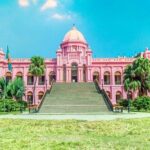Discover Narayanganj District: History, Culture, | Complete Guide

Narayanganj District: A Complete Guide to History, Culture, Economy, and Attractions
Narayanganj District, often referred to as the “Dundee of Bangladesh,” is a bustling hub of history, culture, and economic activity. Located just south of Dhaka, this district is a vital part of the country’s industrial and cultural landscape. Whether you’re a history enthusiast, a culture lover, or an economic researcher, Narayanganj District has something to offer everyone. In this comprehensive guide, we’ll explore the rich heritage, vibrant culture, thriving economy, and top attractions of Narayanganj District.
History of Narayanganj District-
Narayanganj District has a fascinating history that dates back centuries. The name “Narayanganj” is believed to have originated from Bicon Lal Pandey, a Hindu merchant who was also known as Benur Thakur or Lakshmi Narayan Thakur. He established a marketplace, or “ganj,” which eventually became known as Narayanganj.
During the British colonial era, Narayanganj District emerged as a significant center for trade and commerce. Its strategic location along the Shitalakshya River made it a prime spot for jute trading, earning it the nickname “Dundee of Bangladesh” after the Scottish city famous for its jute industry.
The district played a crucial role during the Bangladesh Liberation War in 1971. Many freedom fighters from Narayanganj District actively participated in the struggle for independence, making it a place of historical importance.
Culture of Narayanganj District-
Narayanganj District is a melting pot of cultures, traditions, and religions. The district is home to people from various ethnic and religious backgrounds, including Muslims, Hindus, and Christians. This diversity is reflected in the festivals, rituals, and daily life of the people.
- Festivals and Celebrations
Eid-ul-Fitr and Eid-ul-Adha: Celebrated with great enthusiasm by the Muslim community.
Durga Puja: One of the most significant Hindu festivals, celebrated with grand processions and cultural programs.
Pohela Boishakh: The Bengali New Year is celebrated with colorful events, traditional music, and dance. - Traditional Crafts-
Narayanganj District is renowned for its traditional crafts, particularly the production of muslin cloth. The art of weaving muslin has been passed down through generations, and the district is still known for its high-quality textiles.
Economy of Narayanganj District-
Narayanganj District is one of the most economically vibrant regions in Bangladesh. Its economy is driven by several key industries, including textiles, shipbuilding, and manufacturing.
- Key Industries
1. Textile and Garments: Narayanganj District is a major hub for the textile and garment industry, contributing significantly to Bangladesh’s export earnings.
2. Shipbuilding: The district is home to several shipyards that produce vessels for both domestic and international markets.
3. Jute Processing: Although the jute industry has declined globally, Narayanganj District still plays a vital role in jute processing and export. - Trade and Commerce-
The Shitalakshya River serves as a vital trade route, connecting Narayanganj District to other parts of the country. The district’s markets are bustling with activity, offering everything from fresh produce to handmade crafts.
Top Attractions in Narayanganj District-
Narayanganj District is not just about industry and commerce; it also boasts several tourist attractions that showcase its natural beauty and cultural heritage.
1. Sonakanda Fort
This 17th-century Mughal fort is a must-visit for history buffs. Located on the banks of the Shitalakshya River, the fort offers a glimpse into the region’s rich past.
2. Bandar Shahi Mosque
Built during the Mughal era, this mosque is an architectural marvel. Its intricate designs and historical significance make it a popular tourist spot.
3. Adamjee Jute Mills
Once the largest jute mill in the world, Adamjee Jute Mills is a symbol of Narayanganj District’s industrial heritage. Although the mill is no longer operational, it remains a place of historical interest.
4. Shitalakshya River
The Shitalakshya River is the lifeline of Narayanganj District. A boat ride along the river offers stunning views of the surrounding landscape and a chance to experience the local way of life.
5. Narayanganj City Center
The city center is a bustling area filled with shops, restaurants, and cultural landmarks. It’s the perfect place to experience the vibrant energy of Narayanganj District.
Conclusion-
Narayanganj District is a fascinating blend of history, culture, and economic vitality. From its rich heritage and vibrant festivals to its thriving industries and stunning attractions, the district offers something for everyone. Whether you’re planning a visit or simply want to learn more about this remarkable region, Narayanganj District is sure to leave a lasting impression.
FAQs About Narayanganj District-
1. What is Narayanganj District famous for?
Narayanganj District is famous for its textile and garment industry, shipbuilding, and historical landmarks like Sonakanda Fort and Bandar Shahi Mosque.
2. How far is Narayanganj District from Dhaka?
Narayanganj District is located approximately 20 kilometers southeast of Dhaka, making it easily accessible by road or river.
3. What are the best things to do in Narayanganj District?
Some of the best things to do in Narayanganj District include visiting historical sites like Sonakanda Fort, exploring the Shitalakshya River, and experiencing the local culture at the city center.
4. Why is Narayanganj called the “Dundee of Bangladesh”?
Narayanganj is called the “Dundee of Bangladesh” because of its historical significance in the jute industry, similar to Dundee in Scotland.
5. What is the best time to visit Narayanganj District?
The best time to visit Narayanganj District is during the winter months (November to February) when the weather is pleasant and ideal for sightseeing.